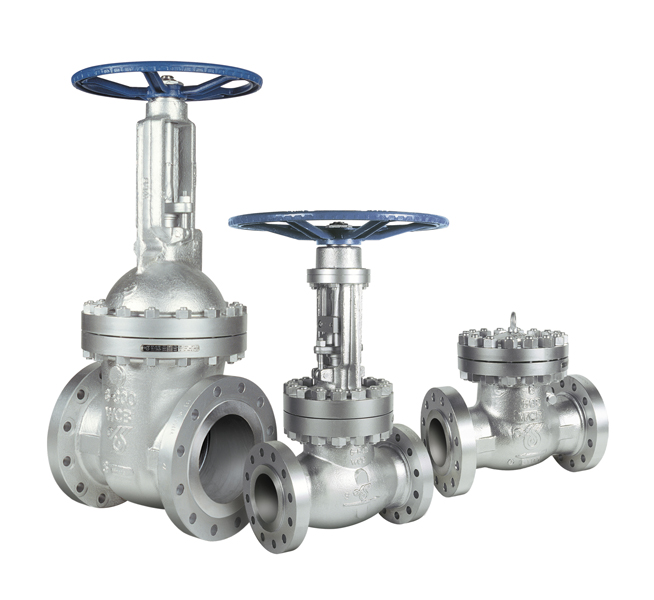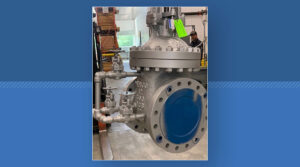Gate valves serve in isolation applications where they can either completely shut off or allow full flow in a pipeline. Their compatibility with a variety of fluids, as well as simplistic operation, make them very common in industrial applications. This article delves into the working principle of gate valves, types, and an intro to common industrial applications.

Working Principle of Gate Valves
Before an introduction to how gate valves work, it is necessary to know the basic components that enable them to perform their function.
Basic Components of a Gate Valve
There are basic components that make up an industrial gate valve, which are the body, bonnet, and trim.
- Body: This serves as the main pressure-retaining part and encases internal components like the seat and gate. Also, it provides connection to the piping system through a variety of methods like welding, threading, flanging, and fittings.
- Bonnet: Bonnet is another pressure retaining part that sits on top of the valve body. The bonnet guides the valve stem and allows safe connection of the disc/gate to its actuator. In addition, bonnets provide access to internal components for maintenance and repair and form a leak-proof closure with the body. This closure/connection could be in the form of screws, bolts, union, welding, or a pressure seal.
- Trim: A gate valve trim consists of its stem, disc/gate, and seat. The stem serves in transferring motion from the actuator to the disc, while the disc moves in or out of the flow path to either prevent or allow flow, respectively.
How Do Gate Valves Work?
Although the actuation of gate valves could be by several methods, the working principle remains the same. Opening the valve entails lifting the valve disc, which creates a straight path for fluid flow through the valve body. Because the disc’s path is perpendicular to the flow, it offers no obstruction to flow in the fully open position. As a result, pressure drop is minimal across gate valves and enables them to deliver high CV values in several applications. On the other hand, closing the valve entails lowering the disc to engage with the seat to create a seal. In manual actuation, rotating a handwheel controls the on/off mechanism, where the clockwise and anticlockwise directions are usually for closing and opening. Alternative methods such as pneumatic, hydraulic, and electric provide faster operation for gate valves, making them suitable for critical applications.
The design of gate valves is solely for isolation and should not serve in throttling applications. This is because throttling a gate valve results in vibration and cavitation that can damage the disc and seat, leading to leakages.
Types of Gate Valves
The classification of gate valves depends on the design of the disc, stem, and seat.

Intro to Gate Types
Although there are several variations of gate valve construction, they generally follow two patterns, which are wedge type and parallel type.
- Wedge Type: This type of gate valves have their disc slightly inclined against the flow path. These discs could be in the form of solid, flexible, and split wedge. Solid wedge is a single-piece construction that offers the simplest and cheapest design of the lot. However, they do not compensate for changes in alignment due to thermal and pressure fluctuations, thus they are susceptible to leakages. As a result they usually serve in applications with temperatures below 250℉ and valve sizes NPS 2 and smaller. The flexible wedge is also a single-piece construction but has hollowed-out areas behind the seating surfaces. This compensates for changes in seat alignment and provides better sealing while maintaining the strength of a solid wedge.
A split wedge gate valve consists of two-piece construction, which sit flat against the valve seats when the stem is downward but move away from each other when pulling upward from the valve seats. The two pieces are held in place by a spring or spacer giving it the ability to self-adjust to the seat. This is essential in providing flexibility and minimizing the risk of sticking or binding.
- Parallel Type: This type of gate valve forms a seal by its discs gradually sliding onto the valve seat. As a result, it is not susceptible to jamming, which makes them ideal for motor actuation, high-temperature, and high-pressure applications.
Intro to Seat Types in Gate Valves
Seats for gate valves are either integral with the valve body or in a seat ring construction. Integral seats are of the same material as the valve body and does not provide flexibility in construction material, whereas seat ring construction allows for different kinds of materials to be either threaded into position or pressed and seal-welded to the valve body. The seal-welding option is preferable for high-temperature service.
Intro to Stems for Gate Valves
Gate valve stems serve in transferring motion from the valve actuator to the disc with threading to either one of them. When the stem and disc are threaded, the stem does not move upwards and downwards as the valve opens and closes. This type of construction is a non-rising stem valve. In contrast, if the stem and actuator are threaded, the disc maintains a rigid connection to the stem. Thus, they rise and fall together during valve operation, making it a rising stem gate valve. You can find details of this construction in our rising vs non-rising stem valves article.
Common Applications
The simple construction of gate valves make them common in several industries including oil & gas, power generation, and water distribution. However, at high pressure, they could become difficult to operate, so they usually have a bypass with a smaller valve. This helps to reduce pressure and ease operation of the valve. Some applications where gate valves excel include:
- Water Distribution: Gate valves are common in water distribution networks as metering is not usually a requirement. Also, water systems are more tolerant to leakages.
- Viscous Media and Slurries: Gate valves offer minimal pressure drop across flow paths, which is ideal for viscous media and slurries. Also, variations like a knife-gate valve can easily cut through slurries to ensure a tight seal when closing the valve.
Selecting the Right Gate Valve with QRC
At QRC Valves, we offer a wide range of high-quality gate valves designed to meet the diverse needs of various industries. Our experienced team can assist you in selecting the most suitable gate valve for your application, ensuring optimal performance and reliability. Contact us today to learn more about our gate valve solutions.


